Potential of CNT-Enhanced Steel-Reinforced Concrete to Reduce the Impact of Water Management Facilities
Abstract
1. Introduction
2. Materials and Methods
2.1. Structural Design of Model A and Model B
2.1.1. Model A and Model B Mechanical Properties
2.1.2. Model A and Model B Design
2.2. Life Cycle Assessment Method
2.2.1. Goal of the Study
2.2.2. Scope of the Study
| Ion on Zeolite Powder (Catalyst) | Units | Batch (0.22 GR) | Mass (g) |
|---|---|---|---|
| Catalyst Produced | g | 0.22 | 10.00 |
| Consumption | |||
| Iron III chloride, 40% in water | g | 1.19 | 54.10 |
| Deionized water | g | 2.20 | 100.00 |
| Nitrogen | g | 2.77 | 126.00 |
| Energy | |||
| Electricity | kWh | 1.98 × 10−2 | 0.90 |
| Output | |||
| Nitrogen | g | 2.77 | 126.00 |
2.2.3. Inventory Analysis—LCI Modelling Framework
- A1: Extraction and processing of raw materials.
- A2: Transportation to the concrete mixing plant.
- A3: Production at the concrete mixing plant and the obtention of the final product at the factory gate. Including energy consumption and processing of wastes.
- A4: Transportation to the construction site.
- A5: Construction phase. In this case, the installation of steel reinforcements and the pouring of fresh concrete
- -
- Abiotic resource depletion (kg Sb eq).
- -
- Primary energy depletion (MJ).
- -
- Global Warming Potential. GWP 100 (kg CO2 eq).
- -
- Stratospheric ozone depletion potential ODP (kg CFC−11 eq).
- -
- Photochemical ozone formation potential, POCP (C2H4 eq).
- -
- Soil and water acidification AP (kg SO2 eq).
- -
- Eutrophication potential EP (kg PO4--- eq).
- -
- Human toxicity. kg 1,4-DB eq.
2.3. Life Cycle Assessment of Developed Product
2.3.1. Input Data
Data Corresponding to Reinforced Concrete Model A and B
Data Corresponding to Production of MWCNT-Based Concrete Model A
Use of Data
Impact Scores Corresponding to MWCNTs Production
3. Results
3.1. Normalisation Step
3.2. Uncertainty Assessment
3.3. Contribution Analysis
3.4. Sensitivity Analysis
3.4.1. Sensitivity Analysis for Electricity Use
3.4.2. Sensitivity Analysis Transport Use
3.4.3. Considerations Regarding MWCNTs Industrial Production Process
4. Discussion
5. Conclusions
- The calculation of the assessed functional unit shows a 47% reduction in the use of steel reinforcement for Model A.
- The obtained results show a better environmental performance for MWCNT-based concrete, Model A, as the obtained impact scores are clearly lower for the most relevant impact categories. Therefore, the steel use reduction outweighs the impacts associated with the use of MWCNTs.
- The contribution analysis performed for Model A established that electricity is the core flow for the MWCNTs production process. In contrast, the assessed alternative scenario for 100% use of photovoltaic electricity only shows a moderate improvement. This indicates that the impacts corresponding to the use of MWCNT are much lower than the impacts corresponding to the other two main contributors, which are the use of cement and steel.
- To obtain an appropriate estimate of the environmental impacts associated with the current industrial production of MWCNTs, the reduction factors included in [26] were applied. The results obtained for this industrial production scenario demonstrate an improvement in the environmental performance of Model A. This approach is considered to provide a more accurate representation of the current nanoparticle market.
- The conducted uncertainty analysis shows a great dispersion in Human toxicity results. This is in line with the reviewed research. Together with this, nowadays LCA is the method of consensus to evaluate nanoproducts environmental performance. However, research has reported shortcomings regarding this method that affect the evaluation of the Human toxicity impact category.
Supplementary Materials
Author Contributions
Funding
Data Availability Statement
Acknowledgments
Conflicts of Interest
References
- Pappalardo, V.; La Rosa, D. Policies for sustainable drainage systems in urban contexts within performance-based planning approaches. Sustain. Cities Soc. 2020, 52, 101830. [Google Scholar] [CrossRef]
- Maqbool, R.; Wood, H. Containing a sustainable urbanized environment through SuDS devices in management trains. Sci. Total Environ. 2022, 807, 150812. [Google Scholar] [CrossRef]
- Ortiz, A.; Velasco, M.J.; Esbri, O.; Medina, V.; Russo, B. The Economic Impact of Climate Change on Urban Drainage. Sustainability 2021, 13, 71. [Google Scholar] [CrossRef]
- EIB Water Sector Orientation-Building Climate-Resilient Water Systems. European Investment Bank. 2023. Available online: https://www.eib.org/attachments/lucalli/20230016_eib_water_sector_orientation_en.pdf (accessed on 4 August 2025).
- Tondera, K.; Brelot, E.; Fontanel, F.; Cherqui, F.; Nielsen, J.E.; Brüggemann, T.; Naismith, I.; Goerke, M.; López, J.S.; Rieckermann, J.; et al. European stakeholders’ visions and needs for stormwater in future urban drainage systems. Urban Water J. 2023, 20, 831–843. [Google Scholar] [CrossRef]
- Nidheesh, P.; Kumar, M.S. An overview of environmental sustainability in cement and steel production. J. Clean. Prod. 2019, 231, 856–871. [Google Scholar] [CrossRef]
- IPCC. Climate Change 2014: Mitigation of Climate Change: Working Group III Contribution to the IPCC Fifth Assessment Report; Cambridge University Press: Cambridge, UK, 2015. [CrossRef]
- Tautorat, P.; Lalin, B.; Schmidt, T.S.; Steffen, B. Directions of innovation for the decarbonization of cement and steel production–A topic modeling-based analysis. J. Clean. Prod. 2023, 407, 137055. [Google Scholar] [CrossRef]
- Wang, P.; Ryberg, M.; Yang, Y.; Feng, K.; Kara, S.; Hauschild, M.; Chen, W.Q. Efficiency stagnation in global steel production urges joint supply- and demand-side mitigation efforts. Nat. Commun. 2021, 12, 2066. [Google Scholar] [CrossRef] [PubMed]
- Cantini, A.; Leoni, L.; De Carlo, F.; Salvio, M.; Martini, C.; Martini, F. Technological energy efficiency improvements in cement industries. Sustainability 2021, 13, 3810. [Google Scholar] [CrossRef]
- Burman, T.; Engvall, J. Evaluation of Usage of Plasma Torches in Cement Production—A Heat Transfer Modelling Study. Master’s Thesis, Chalmers University of Technology, Gothenburg, Sweden, 2019. [Google Scholar]
- Olabi, A.G.; Wilberforce, T.; Elsaid, K.; Sayed, E.T.; Maghrabie, H.M.; Abdelkareem, M.A. Large scale application of carbon capture to process industries—A review. J. Clean. Prod. 2022, 362, 132300. [Google Scholar] [CrossRef]
- Sharma, M.; Bishnoi, S.; Martirena, F.; Scrivener, K. Limestone calcined clay cement and concrete: A state-of-the-art review. Cem. Concr. Res. 2021, 149, 106564. [Google Scholar] [CrossRef]
- Marsh, A.T.M.; Velenturf, A.P.M.; Bernal, S.A. Circular Economy strategies for concrete: Implementation and integration. J. Clean. Prod. 2022, 362, 132486. [Google Scholar] [CrossRef]
- Ohman, A.; Karakaya, E.; Urban, F. Enabling the transition to a fossil-free steel sector: The conditions for technology transfer for hydrogen-based steelmaking in Europe. Energy Res. Soc. Sci. 2022, 84, 102384. [Google Scholar] [CrossRef]
- Suopajärvi, H.; Umeki, K.; Mousa, E.; Hedayati, A.; Romar, H.; Kemppainen, A.; Wang, C.; Phounglamcheik, A.; Tuomikoski, S.; Norberg, N.; et al. Use of biomass in integrated steelmaking e status quo, future needs and comparison to other low-CO2 steel production technologies. Appl. Energy 2018, 213, 384–407. [Google Scholar] [CrossRef]
- Sharma, N.; Nurni, V.N.; Tathavadkar, V.; Basu, S. A review on the generation of solid wastes and their utilization in Indian steel industries. Miner. Process. Extr. Metall. 2017, 126, 54–61. [Google Scholar] [CrossRef]
- Sila Temizel-Sekeryan Fan Wu Andrea, L. Hicks. Global scale life cycle environmental impacts of single and multi-walled carbon nanotube synthesis processes. Int. J. Life Cycle Assess. 2021, 26, 656–672. [Google Scholar] [CrossRef]
- Utsev, T.; Tiza, T.M.; Mogbo, O.; Singh, S.K.; Chakravarti, A.; Shaik, N.; Singh, S.P. Application of nanomaterials in civil engineering. Mater. Today Proc. 2022, 62, 5140–5146. [Google Scholar] [CrossRef]
- Siddique, R.; Mehta, A. Effect of carbon nanotubes on properties of cement mortars. Constr. Build. Mater. 2014, 50, 116–129. [Google Scholar] [CrossRef]
- Jayakumari, B.Y.; Swaminathan, E.N.; Partheeban, P. A review on characteristics studies on carbon nanotubes-based cement concrete. Constr. Build. Mater. 2023, 367, 130344. [Google Scholar] [CrossRef]
- Mousavi, M.A.; Sadeghi-Nik, A.; Bahari, A.; Jin, C.; Ahmed, R.; Ozbakkaloglu, T.; de Brito, J. Strength optimization of cementitious composites reinforced by carbon nanotubes and Titania nanoparticles. Constr. Build. Mater. 2021, 303, 124510. [Google Scholar] [CrossRef]
- Wu, F.; Zhou, Z.; Temizel-Sekeryan, S.; Ghamkhar, R.; Hicks, A.L. Assessing the environmental impact and payback of carbon nanotube supported CO2 capture technologies using LCA methodology. J. Clean. Prod. 2020, 270, 122465. [Google Scholar] [CrossRef]
- Kim, H.C.; Fthenakis, V. Life Cycle Energy and Climate Change. Implications of Nanotechnologies. J. Ind. Ecol. 2013, 17, 528–541. [Google Scholar] [CrossRef]
- Teah, H.Y.; Sato, T.; Namiki, K.; Asaka, M.; Feng, K.; Noda, S. Life Cycle Greenhouse Gas Emissions of Long and Pure Carbon Nanotubes Synthesized via On-Substrate and Fluidized-Bed Chemical Vapor Deposition. ACS Sustain. Chem. Eng. 2020, 8, 1730–1740. [Google Scholar] [CrossRef]
- Gavankar, S.; Suh, S.; Keller, A.A. The Role of Scale and Technology. Maturity in Life Cycle Assessment of Emerging Technologies. A Case Study on Carbon Nanotubes. J. Ind. Ecol. 2014, 19, 51–60. [Google Scholar] [CrossRef]
- Piccinno, F.; Hischier, R.; Seeger, S.; Som, C. Predicting the environmental impact of a future nanocellulose production at industrial scale: Application of the life cycle assessment scale-up framework. J. Clean. Prod. 2018, 174, 283–295. [Google Scholar] [CrossRef]
- Wu, F.; Zhou, Z.; Hicks, A.L. Life Cycle Impact of Titanium Dioxide Nanoparticle Synthesis through Physical, Chemical, and Biological Routes. Environ. Sci. Technol. 2019, 53, 4078–4087. [Google Scholar] [CrossRef]
- Aodkeng, S.; Sinthupinyo, S.; Chamnankid, B.; Hanpongpun, W.; Chaipanich, A. Effect of carbon nanotubes/clay hybrid composite on mechanical properties, hydration heat and thermal analysis of cement-based materials. Constr. Build. Mater. 2022, 320, 126212. [Google Scholar] [CrossRef]
- Mohsen, M.O.; Taha, R.; Abu Taqa, A.; Shaat, A. Optimum carbon nanotubes’ content for improving flexural and compressive strength of cement paste. Constr. Build. Mater. 2017, 150, 395–403. [Google Scholar] [CrossRef]
- Reales, O.A.M.; Toledo Filho, R.D. A review on the chemical, mechanical and microstructural characterization of carbon nanotubes-cement based composites. Constr. Build. Mater. 2017, 154, 697–710. [Google Scholar] [CrossRef]
- Konsta-Gdoutos, M.S.; Aza, C.A. Self sensing carbon nanotube (CNT) and nanofiber (CNF) cementitious composites for real time damage assessment in smart structures. Cem Concr Compos. 2014, 53, 1629. [Google Scholar] [CrossRef]
- Hawreen, A.; Bogas, J. Creep, shrinkage and mechanical properties of concrete reinforced with different types of carbon nanotubes. Constr. Build. Mater. 2019, 198, 70–81. [Google Scholar] [CrossRef]
- Vesmawala, G.R.; Vaghela, A.R.; Yadav, K.; Patil, Y. Effectiveness of polycarboxylate as a dispersant of carbon nanotubes in concrete. Mater. Today Proc. 2020, 28, 1170–1174. [Google Scholar] [CrossRef]
- Konsta-Gdoutos, M.S.; Metaxa, Z.S.; Shah, S.P. Multi-scale mechanical and fracture characteristics and early-age strain capacity of high performance carbon nanotube/cement nanocomposites. Cem. Concr. Compos. 2010, 32, 110–115. [Google Scholar] [CrossRef]
- Kim, G.; Nam, I.; Yang, B.; Yoon, H.; Lee, H.; Park, S. Carbon nanotube (CNT) incorporated cementitious composites for functional construction materials: The state of the art. Compos. Struct. 2019, 227, 111244. [Google Scholar] [CrossRef]
- Han, B.; Yu, X.; Ou, J. Effect of water content on the piezoresistivity of MWNT/cement composites. J. Mater. Sci. 2010, 45, 3714–3719. [Google Scholar] [CrossRef]
- Luo, J.; Duan, Z.; Li, H. The influence of surfactants on the processing of multi-walled carbon nanotubes in reinforced cement matrix composites. Phys. Status Solidi (A) 2009, 206, 2783–2790. [Google Scholar] [CrossRef]
- Collins, F.; Lambert, J.; Duan, W.H. The influences of admixtures on the dispersion, workability, and strength of carbon nanotube–OPC paste mixtures. Cem. Concr. Compos. 2012, 34, 201–207. [Google Scholar] [CrossRef]
- European Chemicals Agency (ECHA). Study of the EU Market for Nanomaterials, Including Substances, Uses, Volumes and Key Operators. European Chemicals Agency. 2022. Available online: https://data.europa.eu/doi/10.2823/680824 (accessed on 4 August 2025).
- Kim, M.; Goerzen, D.; Jena, P.V.; Zeng, E.; Pasquali, M.; Meidl, R.A.; Heller, D.A. Human and environmental safety of carbon nanotubes across their life cycle. Nat. Rev. Mater. 2023, 9, 63–81. [Google Scholar] [CrossRef]
- Salieri, B.; Turner, D.A.; Nowack, B.; Hischier, R. Life cycle assessment of manufactured nanomaterials: Where are we? NanoImpact 2018, 10, 108–120. [Google Scholar] [CrossRef]
- Nizam, N.U.M.; Hanafiah, M.M.; Woon, K.S. A Content Review of Life Cycle Assessment of Nanomaterials: Current Practices, Challenges, and Future Prospects. Nanomaterials 2021, 11, 3324. [Google Scholar] [CrossRef] [PubMed]
- Trompeta, A.-F.; Koklioti, M.A.; Perivoliotis, D.K.; Lynch, I.; Charitidis, C.A. Towards a holistic environmental impact assessment of carbonnanotube growth through chemical vapour deposition. J. Clean. Prod. 2016, 129, 384e394. [Google Scholar] [CrossRef]
- Irshidat, M.R. Bond strength evaluation between steel rebars and carbon nanotubes modified concrete. Case Stud. Constr. Mater. 2021, 14, e00477. [Google Scholar] [CrossRef]
- EN 1990:2002/A1; Eurocode-Basis of Structural Design. European Commission: Brussel, Belgium, 2005.
- EN 1992-1-1; Eurocode 2: Design of Concrete Structures. European Commission: Brussel, Belgium, 2004.
- Evangelista, A.C.J.; de Morais, J.F.; Tam, V.; Soomro, M.; Di Gregorio, L.T.; Haddad, A.N. Evaluation of Carbon Nanotube Incorporation in Cementitious Composite Materials. Materials 2019, 12, 1504. [Google Scholar] [CrossRef]
- ISO 14040:2006(en); Environmental Management—Life Cycle Assessment—Principles and Framework. International Organization for Standardization: Geneva, Switzerland, 2006.
- ISO 14044; Environmental Management. Life Cycle Assessment. Requirements and Guidelines. International Organization for Standardization: Geneva, Switzerland, 2006.
- Goedkoop, M.; Oele, M.; Vieira, M.; Leijting, J.; Ponsioen, T.; Meijer, E. SimaPro Tutorial; PRé Sustainability, B.V.: Amersfoort, The Netherlands, 2016. [Google Scholar]
- EN 15804:2012+A2:2019; Sustainability of Construction Works-Environmental Product Declarations-Core Rules for the Product Category of Construction Products. British Standards Institution (BSI): London, UK, 2019.
- Ecoinvent Database. Available online: https://ecoinvent.org/database/ (accessed on 25 June 2024).
- Li, Q.; Zhu, Y.; Zhao, P.; Yuan, C.; Chen, M.; Wang, C. Commercial activated carbon as a novel precursor of the amorphous carbon for high-performance sodium-ion batteries anode. Carbon 2018, 129, 85–94. [Google Scholar] [CrossRef]
- Kim, T.; Lee, J.; Lee, K.-H. Full graphitization of amorphous carbon by microwave heating. RSC Adv. 2016, 6, 24667–24674. [Google Scholar] [CrossRef]
- ISO 14025:2006(en); Environmental Labels and Declarations—Type III Environmental Declarations—Principles and Procedures. International Organization for Standardization: Geneva, Switzerland, 2006.
- EUR 24708 EN-2010; ILCD Handbook, International Reference Life Cycle Data System. IES, JRC, European Commission: Brussels, Belgium, 2010.
- CML-IA Characterisation Factors. 2016. Available online: https://www.universiteitleiden.nl/en/research/research-output/science/cml-ia-characterisation-factors (accessed on 4 November 2024).
- Sleeswijk, A.W.; van Oers, L.F.; Guinée, J.B.; Struijs, J.; Huijbregts, M.A. Normalisation in product life cycle assessment: An LCA of the global and European economic systems in the year 2000. Sci. Total Environ. 2008, 390, 227–240. [Google Scholar] [CrossRef] [PubMed]
- Ponsioen, T. Pré Sustainability 2014. Normalization: New Developments in Normalization Sets. 2014. Available online: https://pre-sustainability.com/articles/the-normalisation-step-in-lcia/ (accessed on 4 November 2024).
- Coal Explained. Coal and the Environment. U.S. Energy Information Administration. Independent Statistics and Analysis. Available online: https://www.eia.gov/energyexplained/coal/coal-and-the-environment.php#:~:text=Several%20principal%20emissions%20result%20from,respiratory%20illnesses%2C%20and%20lung%20disease (accessed on 2 November 2024).
- EUROPE IN FIGURES—Eurostat Yearbook July 2006. Available online: https://ec.europa.eu/eurostat/documents/3217494/5609869/KS-CD-06-001-01-EN.PDF/ebb28696-2f37-4d37-87c9-e6ac574329c0?version=1.0 (accessed on 12 July 2025).
- Chen, X.; Matthews, H.S.; Griffin, W.M. Uncertainty caused by life cycle impact assessment methods: Case studies in process-based LCI databases. Resour. Conserv. Recycl. 2021, 172, 105678. [Google Scholar] [CrossRef]
- Geisler, G.; Hellweg, S.; Hungerbühler, K. Uncertainty Analysis in Life Cycle Assessment (LCA): Case Study on Plant-Protection Products and Implications for Decision Making. Int. J. Life Cycle Assess. 2005, 10, 184–192. [Google Scholar] [CrossRef]
- Hung, M.-L.; Ma, H.-W. Quantifying system uncertainty of life cycle assessment based on Monte Carlo simulation. Int. J. Life Cycle Assess. 2009, 14, 19–27. [Google Scholar] [CrossRef]
- Barahmand, Z.; Eikeland, M.S. Life Cycle Assessment under Uncertainty: A Scoping Review. World 2022, 3, 692–717. [Google Scholar] [CrossRef]
- EPD Italy. The Norwegian EPD Foundation. DMEGC Bifacial Monocrystalline Photovoltaic Module (N-type cells). In Accordance with ISO 14025. Jiangsu Dongci New Energy Technology Co., Ltd., 2024. Available online: https://www.epditaly.it/en/wp-content/uploads/2016/12/DMEGC-EPD3_Public-report-20240126.pdf (accessed on 2 November 2024).
- Montoya, P.J.; Meseguer, Á.G.; Cabré, F.M.; Portero, J.C.A. Ajustada a Código Modelo y Eurocódigo, 14th ed.; Editorial Gustavo Gili S.L.: Barcelona, Spain, 2000; ISBN 84-252-1825-X, 9788425218255. [Google Scholar]
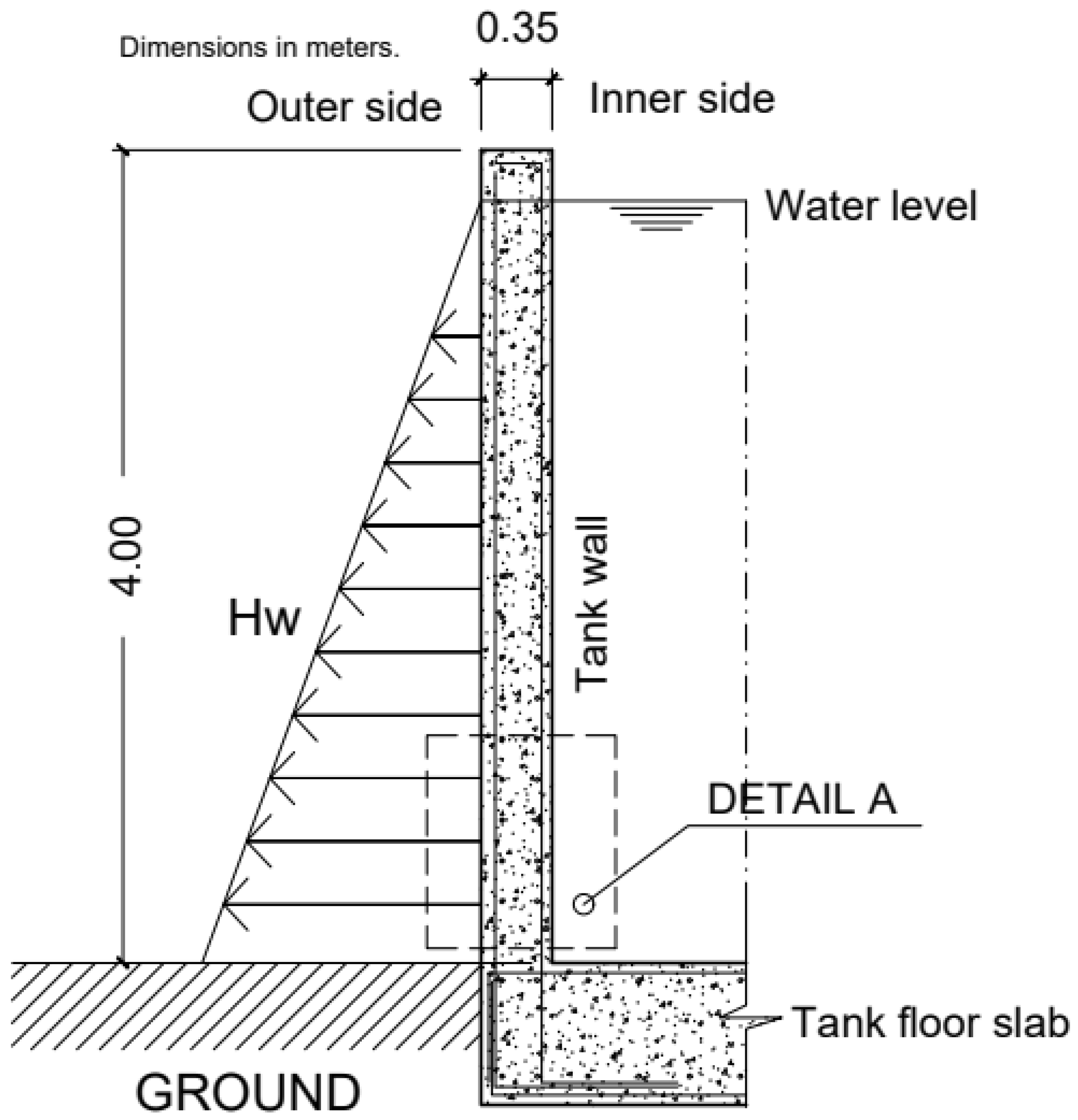

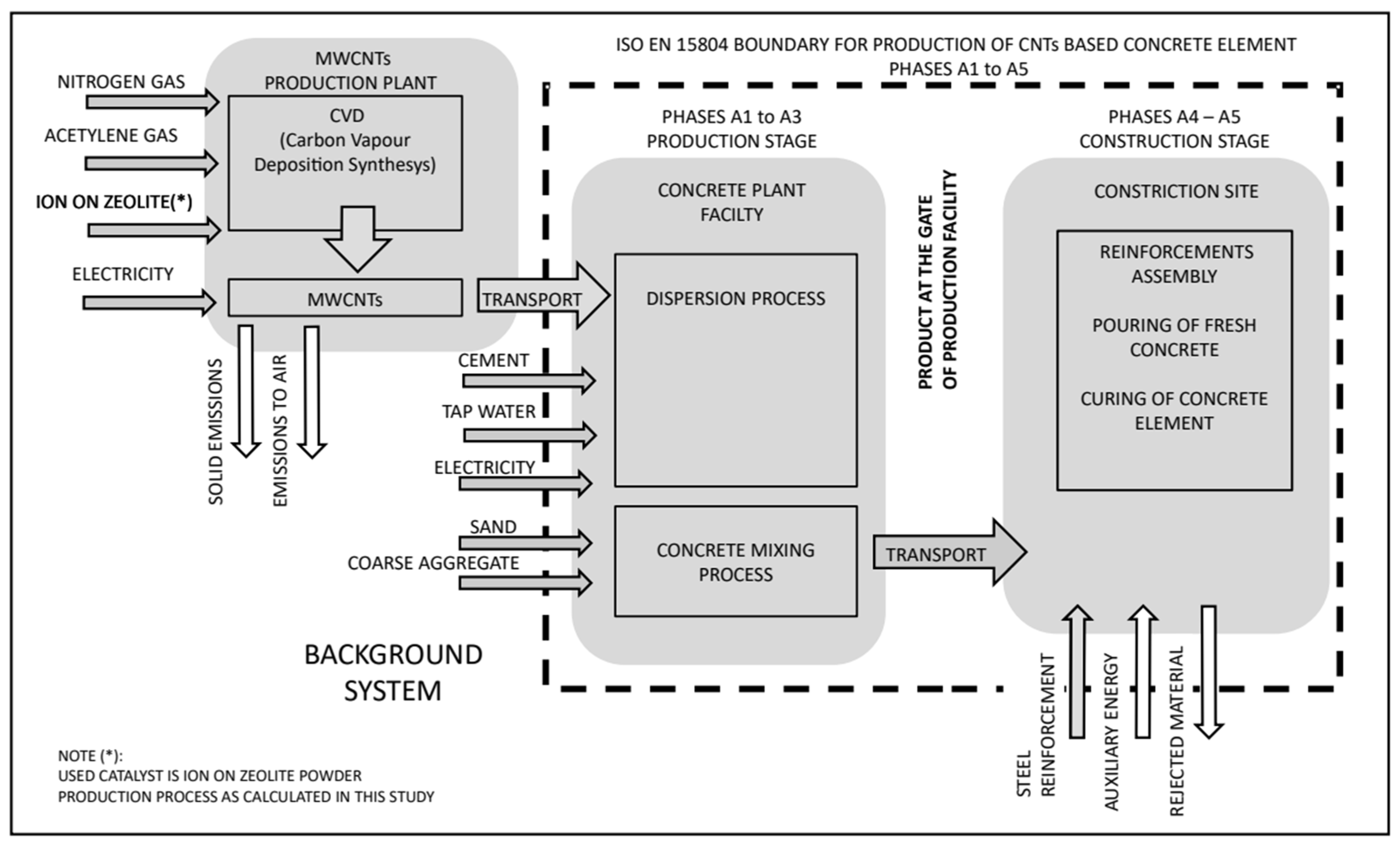
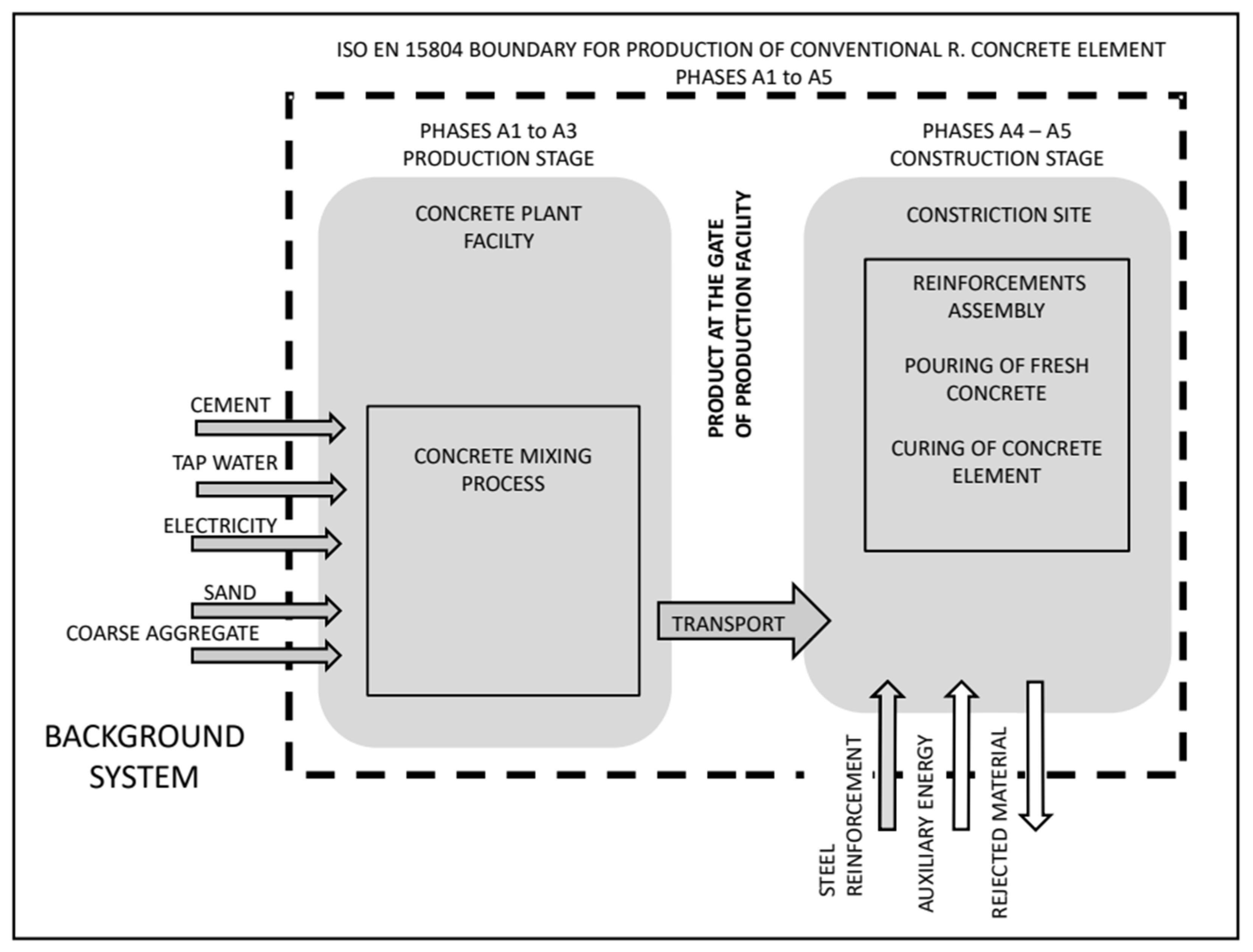
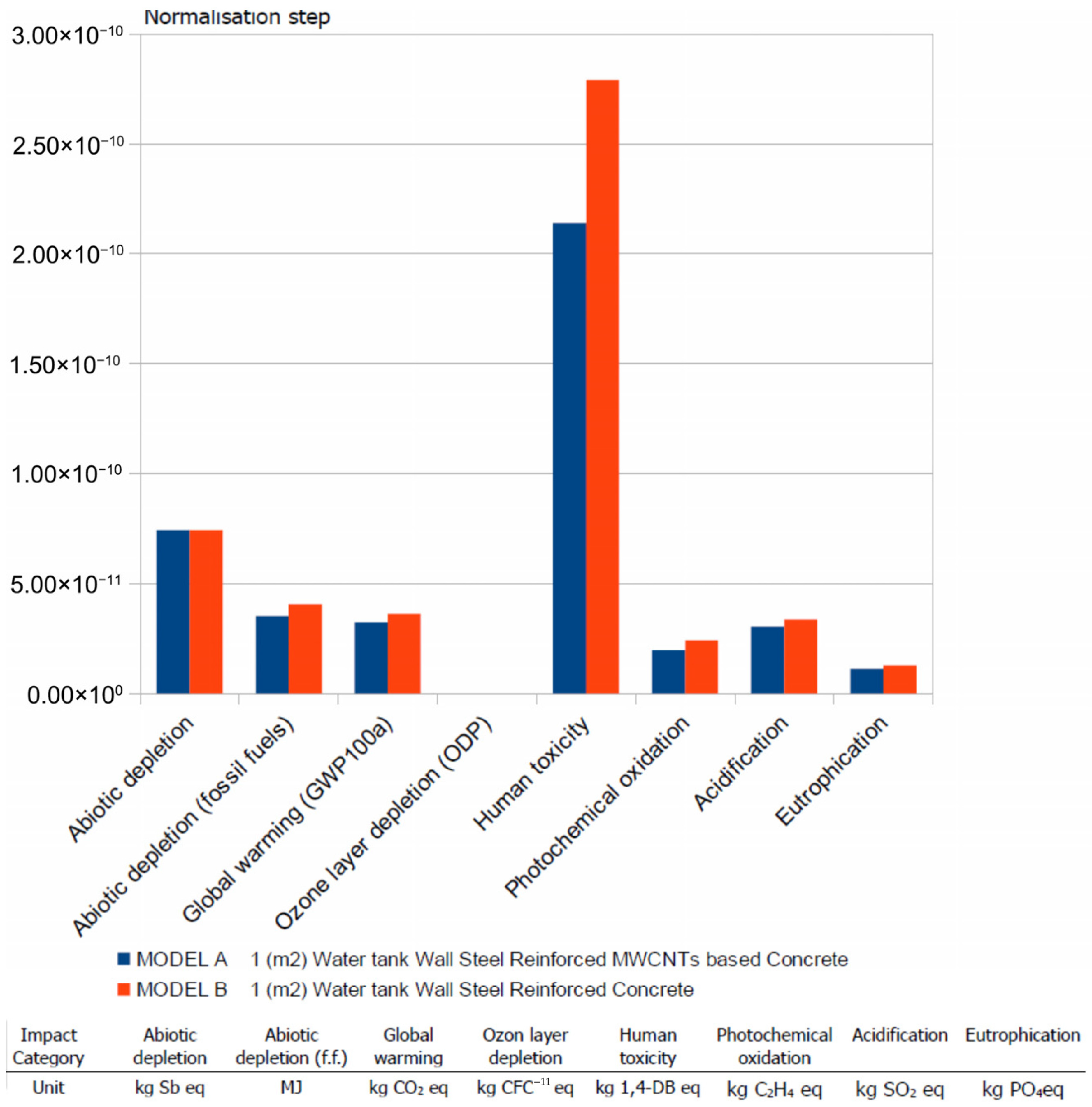
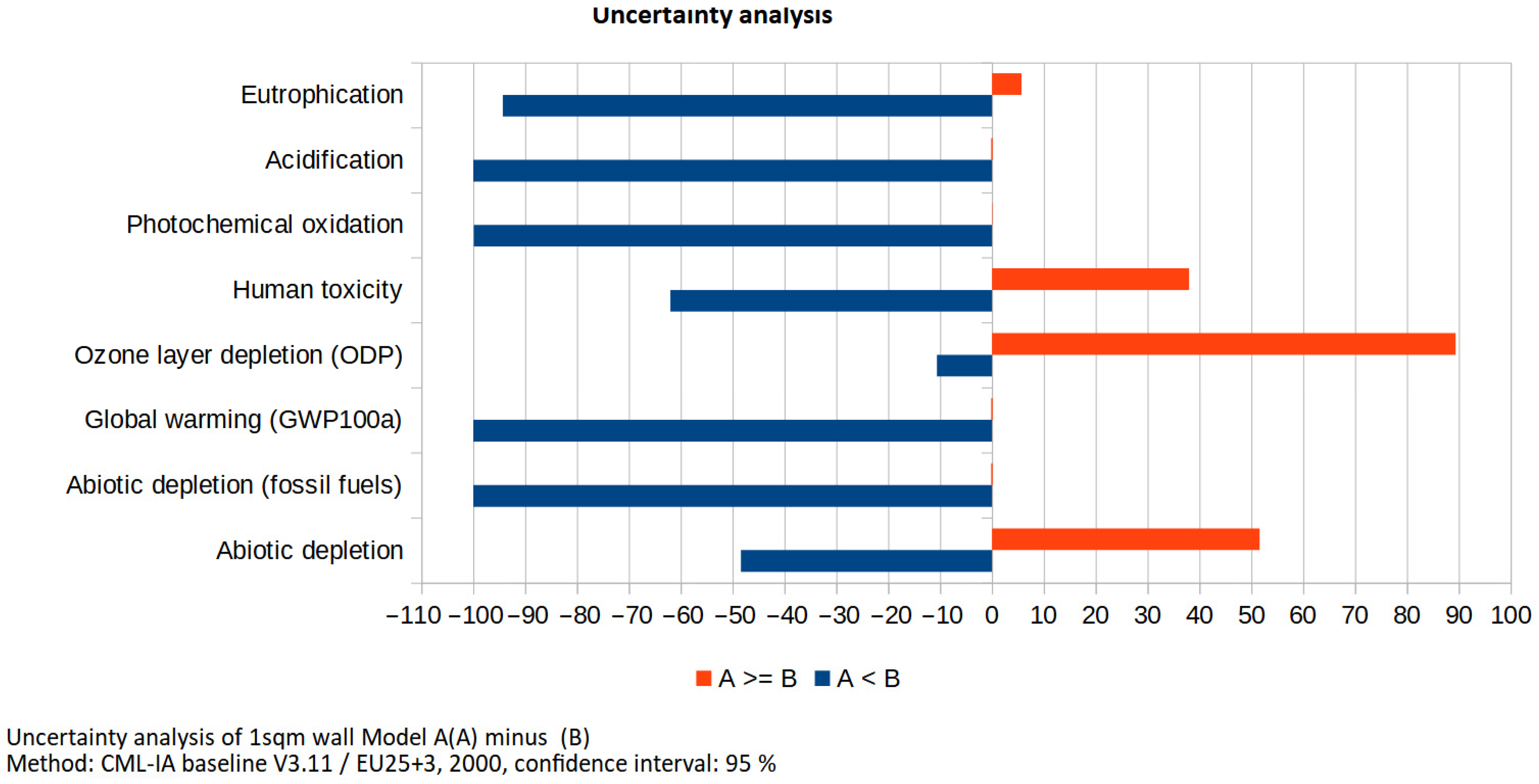
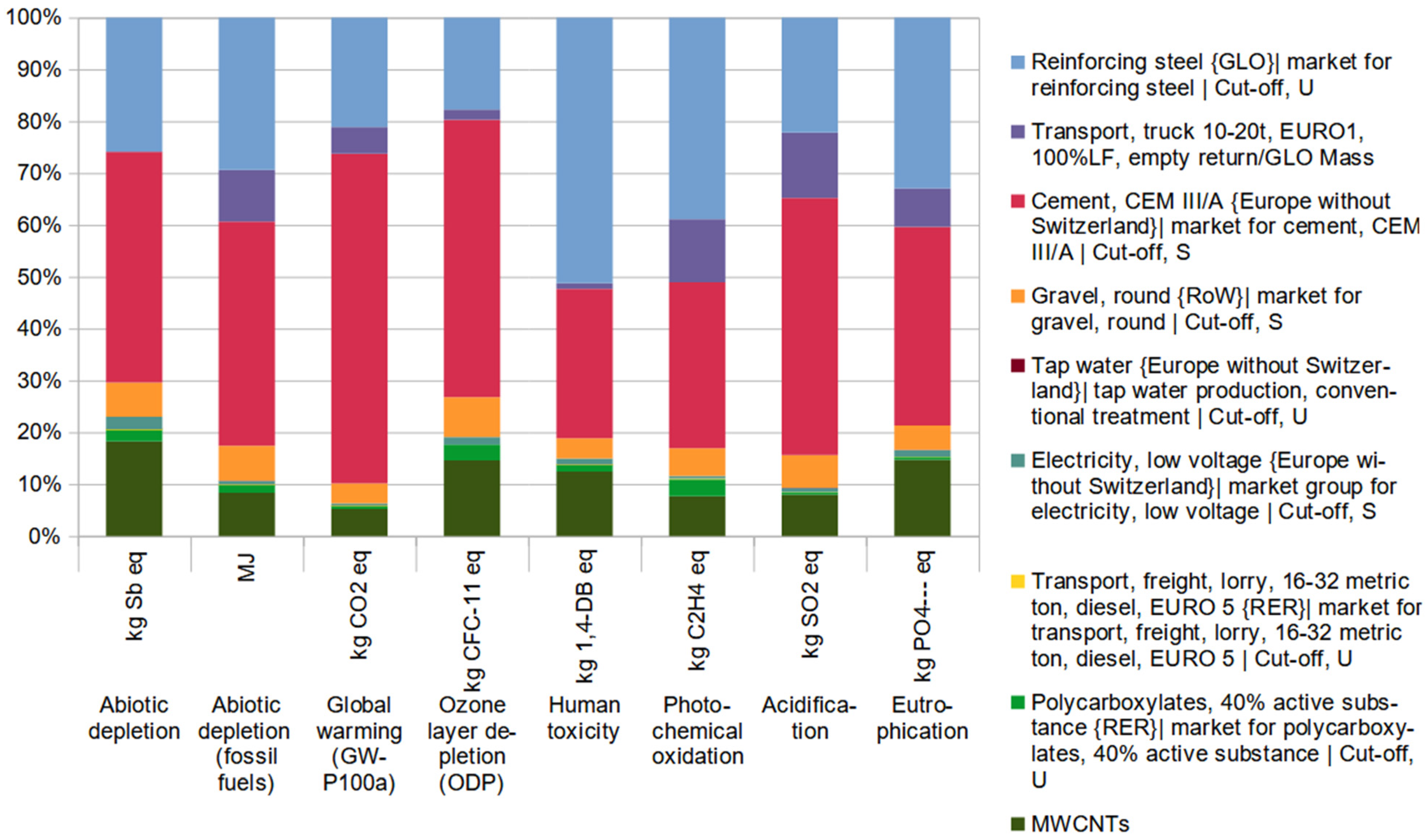
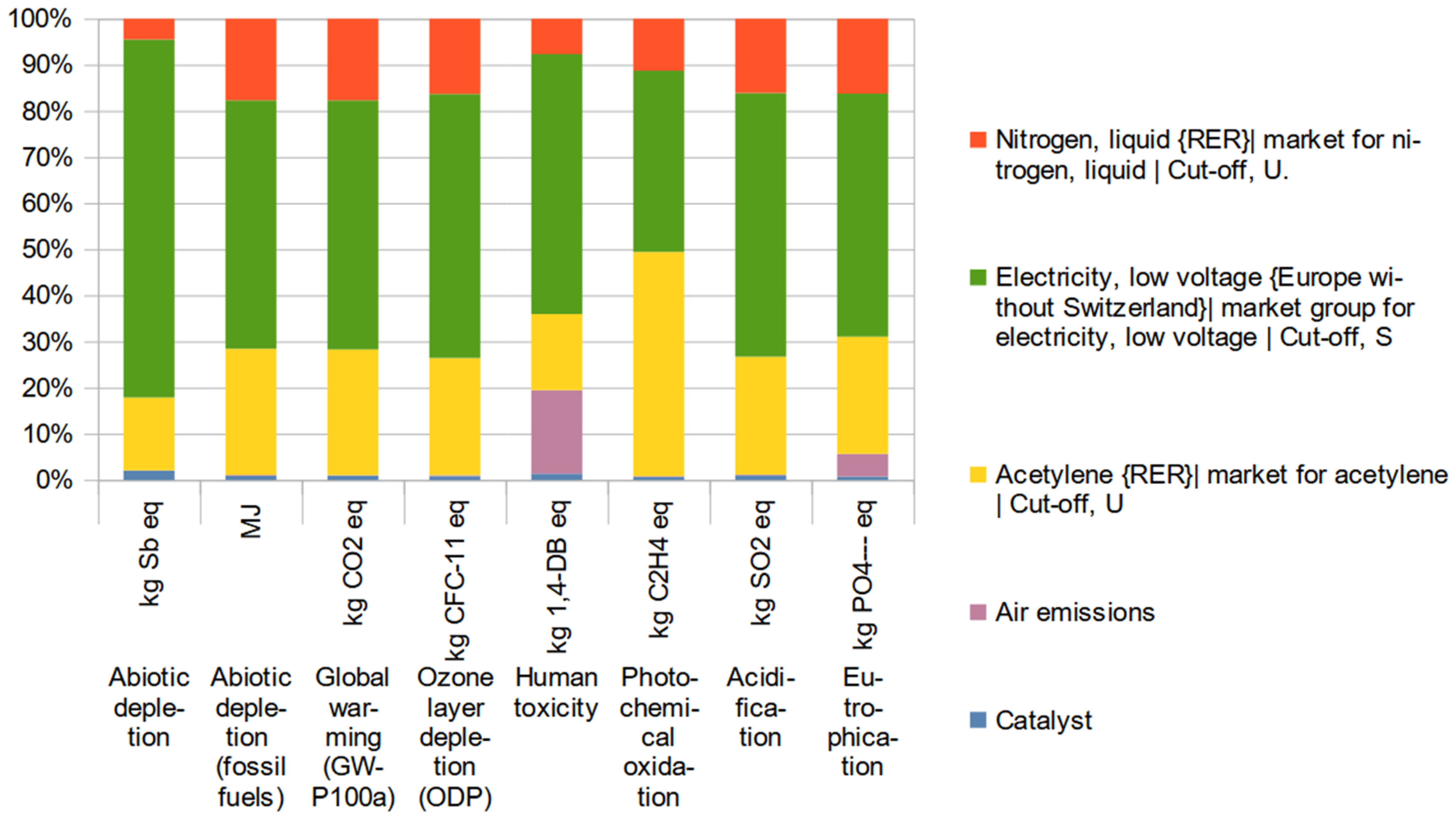
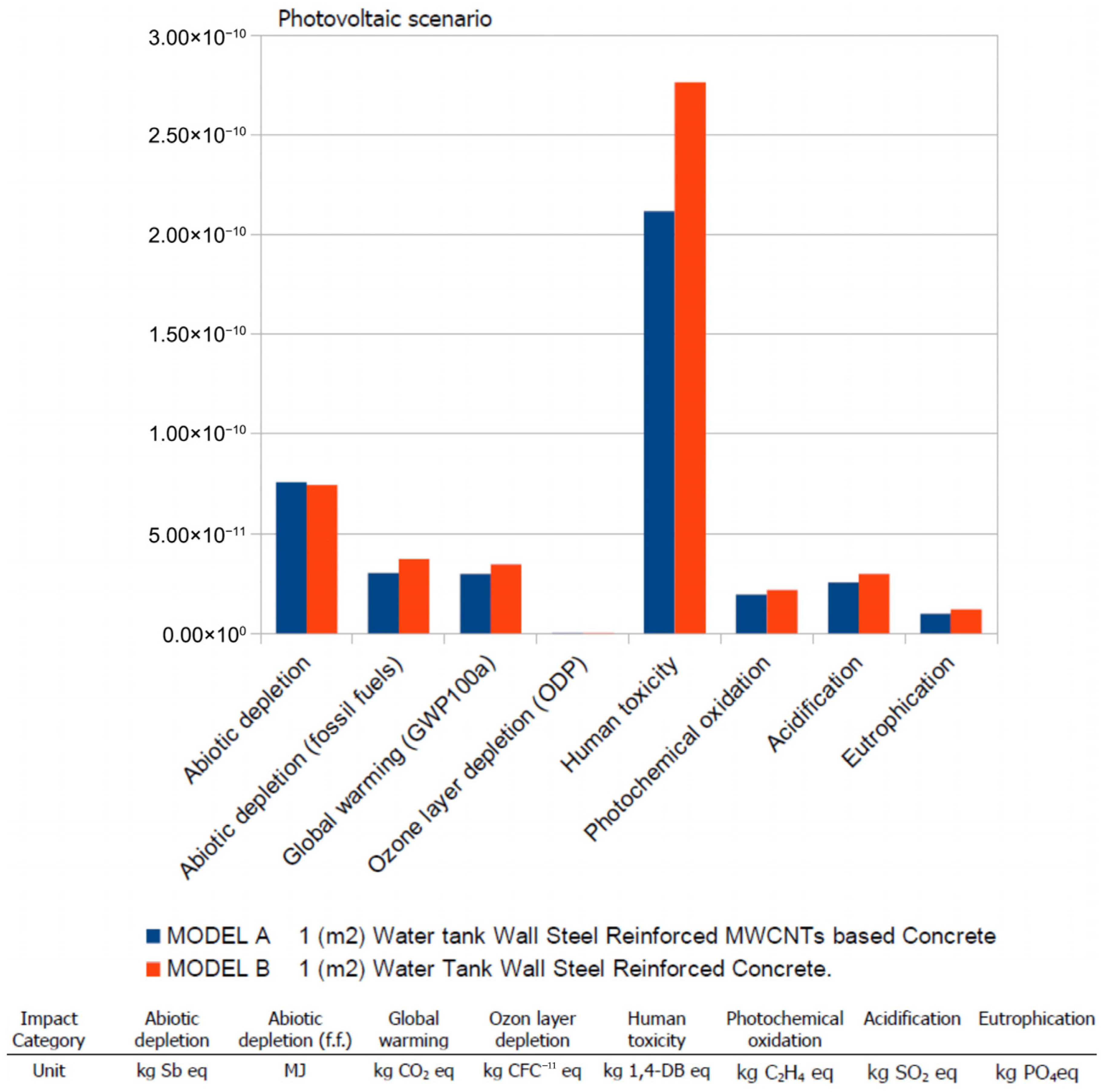
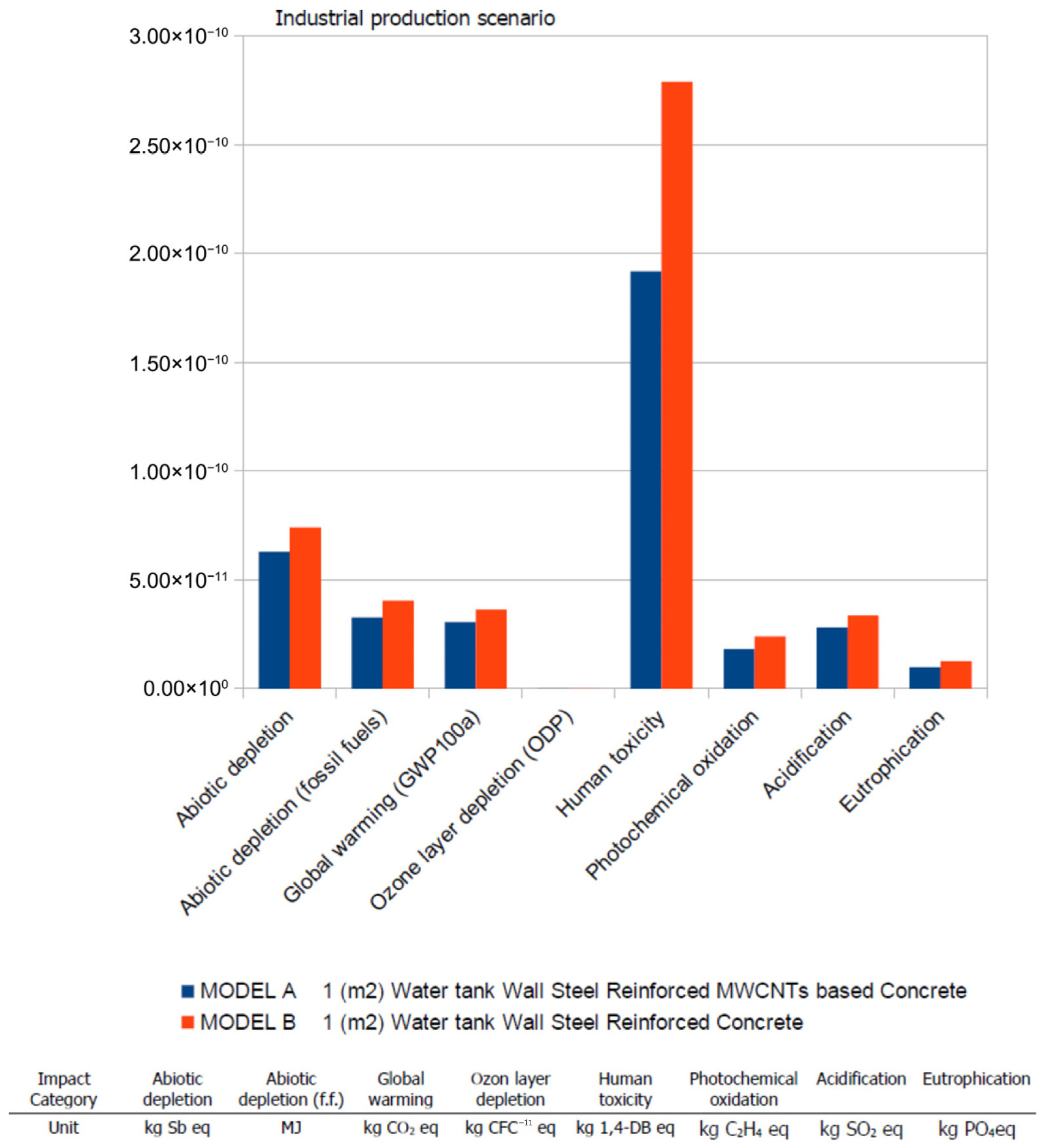
| Geometry (1 m2 Wall) | Unit | Model A | Model B | |
|---|---|---|---|---|
| Width | m | 1.00 | 1.00 | |
| Heigth | m | 1.00 | 1.00 | |
| Depth | m | 0.35 | 0.35 | |
| Tot. volume m3/m2 | m3 | 0.35 | 0.35 | |
| Concrete components (*) C50 (1 m2 Wall) | Unit | Model A | Model B | |
| Cement (Portland type 1) | kg | 193.00 | 193.00 | |
| Sand fineness 2.82 | kg | 213.00 | 214.00 | |
| Coarse aggregate máx. Size 20 mm | kg | 304.00 | 305.00 | |
| Tap water | kg | 94.10 | 94.20 | |
| Polycarboxylate | kg | 0.765 | 0.00 | |
| MWCNTS | kg | 0.385 | 0.00 | |
| Total weight | kg/m2 | 806.00 | 806.00 | |
| C50 concrete characteristics | Unit | Model A (**) | Model B (***) | |
| Fck (Characteristic cylinder compressive strength) | MPa | 61.50 | 50.00 | |
| Fctm (Mean tensile strength) | MPa | 4.98 | 4.07 | |
| Steel reinforcement (****) (1 m2 Wall) | Unit | Model A | Model B | |
| Vertical outer side reinforcement | As2 | kg | 2.75 | 2.75 |
| Vertical inner side reinforcement | As1 | kg | 8.87 | 18.30 |
| Horizontal inner side reinforcement | As3 | kg | 3.26 | 4.57 |
| Horizontal inner side reinforcement | As4 | kg | 3.26 | 4.57 |
| Total steel reinf. | kg/m2 | 16.10 | 30.20 | |
| Transport to concrete plant | Unit | Model A | Model B | |
| Distance | km | 500.00 | 500.00 |
| Synthesis of MWCNTs. CVD Method [44] | Unit | Reference Study Batch | 1 kg MWCNTs |
|---|---|---|---|
| Obtained product | g | 7.50 | 10 × 103 |
| Amorphous carbon (**) | g | 0.188 | 25.00 |
| Consumption | |||
| Electricity (*) | Wh | 10 × 103 | 1.34 × 105 |
| Nitrogen gas | g | 161.00 | 2.14 × 104 |
| Acetylene gas | g | 18.30 | 2.45 × 103 |
| Ion on zeolite powder (***) | g | 0.22 | 29.30 |
| Emissions to air | |||
| Nitrogen gas | g | 161.00 | 2.14 × 104 |
| Acetylene gas | g | 5.45 | 727.00 |
| VOCs | g | 4.00 | 533.00 |
| PAHs | g | 5.00 × 10−2 | 6.67 |
| SOOT | g | 1.00 | 133.00 |
| Elementary Flow | Source | |
|---|---|---|
| MWCNTs Production | Model A | |
| Materials | Generic Data. | |
| Nitrogen gas | Nitrogen, liquid {RER}|market for nitrogen, liquid|Cut-off, U. | Ecoinvent 3.11 database |
| Acetylene gas | Acetylene {RER}|market for acetylene|Cut-off, U | Ecoinvent 3.11 database |
| Iron III chloride, 40% in water | Iron(III) chloride, without water, in 40% solution state {GLO}|market for iron(III) chloride, without water, in 40% solution state|Cut-off, U | Ecoinvent 3.11 database |
| Energy | ||
| Electricity | Electricity, low voltage {Europe without Switzerland}|market group for electricity, low voltage|Cut-off, U | Ecoinvent 3.11 database |
| Transport | Generic Data. | |
| Lorry | Transport, freight, lorry, 16–32 metric ton, diesel, EURO 5 {RER}|market for transport, freight, lorry, 16–32 metric ton, diesel, EURO 5|Cut-off, U | Ecoinvent 3.11 database |
| Emissions to air (1) | Generic Data. | |
| MWCNTs production emissions to air (*) | Hard coal ash {CH}|treatment of hard coal ash, municipal incineration FAE|Cut-off, U | Ecoinvent 3.11 database |
| Dispersion process | Model A | |
| Materials | Generic Data. | |
| Polycarboxylate | Polycarboxylates, 40% active substance {RER}|market for polycarboxylates, 40% active substance|Cut-off, U | Ecoinvent 3.11 database |
| Energy | Generic Data. | |
| Electricity | Electricity, low voltage {Europe without Switzerland}|market group for electricity, low voltage|Cut-off, U | Ecoinvent 3.11 database |
| Reinforced Concrete | Model A, Model B | |
| Materials | Generic Data. | |
| Cement, CEM III/A | ||
| Tap water | Tap water {Europe without Switzerland}|tap water production, conventional treatment|Cut-off, U | Ecoinvent 3.11 database |
| Sand (***) | Gravel, round {RoW}|market for gravel, round|Cut-off, U | Ecoinvent 3.11 database |
| Coarse aggregate | Gravel, round {RoW}|market for gravel, round|Cut-off, U | Ecoinvent 3.11 database |
| Steel reinforcement | Reinforcing steel {GLO}|market for reinforcing steel|Cut-off, U | Ecoinvent 3.11 database |
| Transport | Generic Data. | |
| Truck mixer | Transport, truck 10–20 t, EURO1 100%LF, empty return {GLO} Mass, U (**) | Ecoinvent3.11 database |
| Surfactant-Assisted Ultrasonication | UNIT | Batch [30] | 1 kg Cement | |
|---|---|---|---|---|
| Cement, CEM III/A | g | 2.80 × 103 | 1.00 × 103 | (*) |
| Tap water | g | 1.12 × 103 | 400.00 | (*) |
| Polycarboxylate | g | 11.20 | 4.00 | |
| MWCNT (optimus) | g | 2.80 | 1.00 | (*) |
| Electricity | ||||
| Ultrasonic wave mixer (Sonic&Materials Inc., Newtown, CT, USA) VCX 1500 capacidad 10l/1.5 kw | Wh | 84.00 | 30.00 | |
| Planetary laboratory mixer. (Hobart, Troy, OH, USA) supplied by Hobart. HL 400/133L/3.7 kw | Wh | 31.20 | 11.10 | |
| Temperature of the water is 23 °C | Wh | 10.80 | 3.84 | |
| Total electricity | Wh | 131.00 | 46.90 |
| Impact Category | Unit | 1 kg of Catalyst (Ion on Zeolite Powder) |
|---|---|---|
| Abiotic depletion | kg Sb eq | 1.47 × 10−4 |
| Abiotic depletion (fossil fuels) | MJ | 78.40 |
| Global warming (GWP100a) | kg CO2 eq | 7.05 |
| Ozone layer depletion (ODP) | kg CFC−11 eq | 9.32 × 10−8 |
| Human toxicity | kg 1,4-DB eq | 15.70 |
| Photochemical oxidation | kg C2H4 eq | 1.55 × 10−3 |
| Acidification | kg SO2 eq | 3.58 × 10−2 |
| Eutrophication | kg PO4 eq | 1.96 × 10−2 |
| Impact Category | Unit | 1 kg MWCNTs |
|---|---|---|
| Abiotic depletion | kg Sb eq | 2.13 × 10−4 |
| Abiotic depletion (fossil fuels) | MJ | 269.00 |
| Global warming (GWP100a) | kg CO2 eq | 23.00 |
| Ozone layer depletion (ODP) | kg CFC−11 eq | 3.42 × 10−7 |
| Human toxicity | kg 1,4-DB eq | 34.70 |
| Photochemical oxidation | kg C2H4 eq | 6.78 × 10−3 |
| Acidification | kg SO2 eq | 0.106 |
| Eutrophication | kg PO4 eq | 8.09 × 10−2 |
| Impact Category | Unit | Model A 1.00 m2 Tank Wall MWCNT-Based R. Concrete | Model B 1.00 m2 Tank Wall Conventional R. Concrete |
|---|---|---|---|
| Abiotic depletion | kg Sb eq | 4.47 × 10−4 | 4.47 × 10−4 |
| Abiotic depletion (fossil fuels) | MJ | 1.23 × 103 | 1.43 × 103 |
| Global warming (GWP100a) | kg CO2 eq | 168.00 | 189.00 |
| Ozone layer depletion (ODP) | kg CFC−11 eq | 8.95 × 10−7 | 8.67 × 10−7 |
| Human toxicity | kg 1,4-DB eq | 107.00 | 140.00 |
| Photochemical oxidation | kg C2H4 eq | 3.39 × 10−2 | 4.16 × 10−2 |
| Acidification | kg SO2 eq | 0.512 | 0.567 |
| Eutrophication | kg PO4 eq | 0.211 | 0.237 |
| Impact Category | Unit | (Indv. Imp.) (*) | Model A/(Indv. Imp.) (%) | Model B/(Indv. Imp.) (%) |
|---|---|---|---|---|
| Abiotic depletion | kg Sb eq | 1.24 × 10−2 | 3.60 | 3.60 |
| Abiotic depletion (fossil fuels) | MJ | 7.22 × 104 | 1.70 | 1.98 |
| Global warming (GWP100a) | kg CO2 eq | 1.07 × 104 | 1.57 | 1.76 |
| Ozone layer depletion (ODP) | kg CFC−11 eq | 2.10 × 10−2 | 4.26 × 10−3 | 4.13 × 10−3 |
| Human toxicity | kg 1,4-DB eq | 1.03 × 103 | 10.40 | 13.60 |
| Photochemical oxidation | kg C2H4 eq | 3.56 | 0.952 | 1.17 |
| Acidification | kg SO2 eq | 5.94 × 10−11 | 1.48 | 1.64 |
| Eutrophication | kg PO4 eq | 5.40 × 10−11 | 0.553 | 0.622 |
| Model A | |||||
|---|---|---|---|---|---|
| Impact Category | Unit | Mean | Median | Standard Deviation | Coefficient of Variation |
| Abiotic depletion | kg Sb eq | 7.42 × 10−11 | 6.95 10−11 | 2.11 × 10−11 | 28.40% |
| Abiotic depletion (fossil fuels) | MJ | 3.53 × 10−11 | 3.49 × 10−11 | 3.72 × 10−12 | 10.50% |
| Global warming (GWP100a) | kg CO2 eq | 3.25 x 10−11 | 3.21 × 10−11 | 3.96 × 10−12 | 12.20% |
| Ozone layer depletion (ODP) | kg CFC−11 eq | 2.47 × 10−13 | 2.46 × 10−13 | 2.44 × 10−14 | 9.89% |
| Human toxicity | kg 1,4-DB eq | 2.18 × 10−10 | 2.09 × 10−10 | 7.96 × 10−10 | 364.00% |
| Photochemical oxidation | kg C2H4 eq | 1.95 × 10−11 | 1.87 × 10−11 | 3.51 × 10−12 | 17.90% |
| Acidification | kg SO2 eq | 3.10 × 10−11 | 3.09 × 10−11 | 2.23 × 10−12 | 7.17% |
| Eutrophication | kg PO4 eq | 1.14 × 10−11 | 1.08 × 10−11 | 3.11 × 10−12 | 27.20% |
| Model B | |||||
| Impact Category | Unit | Mean | Median | Standard Deviation | Coefficient of Variation |
| Abiotic depletion | kg Sb eq | 7.44 × 10−11 | 6.96 × 10−11 | 2.24 × 10−11 | 30.10% |
| Abiotic depletion (fossil fuels) | MJ | 4.08 × 10−11 | 3.98 × 10−11 | 5.81 × 10−12 | 14.20% |
| Global warming (GWP100a) | kg CO2 eq | 3.64 × 10−11 | 3.60 × 10−11 | 4.18 × 10−12 | 11.50% |
| Ozone layer depletion (ODP) | kg CFC−11 eq | 2.43 × 10−13 | 2.42 × 10−13 | 2.50 × 10−14 | 10.30% |
| Human toxicity | kg 1,4-DB eq | 2.75 × 10−10 | 2.58 × 10−10 | 9.95 × 10−10 | 362.00% |
| Photochemical oxidation | kg C2H4 eq | 2.40 × 10−11 | 2.23 × 10−11 | 7.10 × 10−12 | 29.60% |
| Acidification | kg SO2 eq | 3.41 × 10−11 | 3.40 × 10−11 | 2.68 × 10−12 | 7.84% |
| Eutrophication | kg PO4 eq | 1.29 × 10−11 | 1.22 × 10−11 | 3.64 × 10−12 | 28.20% |
| Impact Category | Unit | Impact Reduction | (%) Improv. |
|---|---|---|---|
| Abiotic depletion | kg Sb eq | −8.80 × 10−6 | −1.97 |
| Abiotic depletion (fossil fuels) | MJ | 244.00 | 18.80 |
| Global warming (GWP100a) | kg CO2 eq | 25.80 | 14.30 |
| Ozone layer depletion (ODP) | kg CFC-11 eq | −6.54 × 10−8 | −7.70 |
| Human toxicity | kg 1,4-DB eq | 32.50 | 23.50 |
| Photochemical oxidation | kg C2H4 eq | 7.37 × 10−2 | 11.10 |
| Acidification | kg SO2 eq | 0.108 | 14.70 |
| Eutrophication | kg PO4--- eq | 4.53 × 10−2 | 20.40 |
| Impact Category | Unit | Impact Increase | Variation (%) |
|---|---|---|---|
| Abiotic depletion | kg Sb eq | 2.61 × 10−6 | 0.583 |
| Abiotic depletion (fossil fuels) | MJ | 4.64 | 0.377 |
| Global warming (GWP100a) | kg CO2 eq | 0.229 | 0.136 |
| Ozone layer depletion (ODP) | kg CFC-11 eq | 6.70 × 10−9 | 0.748 |
| Human toxicity | kg 1,4-DB eq | 0.357 | 0.334 |
| Photochemical oxidation | kg C2H4 eq | 2.31 × 10−4 | 0.681 |
| Acidification | kg SO2 eq | 5.49 × 10−4 | 0.107 |
| Eutrophication | kg PO4--- eq | 2.43 × 10−4 | 0.116 |
| Impact Category | Unit | Impact Reduction | (%) Improv. |
|---|---|---|---|
| Abiotic depletion | kg Sb eq | 6.83 × 10−5 | 15.30 |
| Abiotic depletion (fossil fuels) | MJ | 279.00 | 19.60 |
| Global warming (GWP100a) | kg CO2 eq | 29.10 | 15.40 |
| Ozone layer depletion (ODP) | kg CFC-11 eq | 8.15 × 10−8 | 9.39 |
| Human toxicity | kg 1,4-DB eq | 43.60 | 31.30 |
| Photochemical oxidation | kg C2H4 eq | 1.01 × 10−2 | 24.20 |
| Acidification | kg SO2 eq | 9.17 × 10−2 | 16.20 |
| Eutrophication | kg PO4--- eq | 5.50 × 10−2 | 23.20 |
Disclaimer/Publisher’s Note: The statements, opinions and data contained in all publications are solely those of the individual author(s) and contributor(s) and not of MDPI and/or the editor(s). MDPI and/or the editor(s) disclaim responsibility for any injury to people or property resulting from any ideas, methods, instructions or products referred to in the content. |
© 2025 by the authors. Licensee MDPI, Basel, Switzerland. This article is an open access article distributed under the terms and conditions of the Creative Commons Attribution (CC BY) license (https://creativecommons.org/licenses/by/4.0/).
Share and Cite
Sánchez-Burgos, M.A.; Trompeta, A.-F.; Mercader-Moyano, P. Potential of CNT-Enhanced Steel-Reinforced Concrete to Reduce the Impact of Water Management Facilities. Buildings 2025, 15, 2818. https://doi.org/10.3390/buildings15162818
Sánchez-Burgos MA, Trompeta A-F, Mercader-Moyano P. Potential of CNT-Enhanced Steel-Reinforced Concrete to Reduce the Impact of Water Management Facilities. Buildings. 2025; 15(16):2818. https://doi.org/10.3390/buildings15162818
Chicago/Turabian StyleSánchez-Burgos, Marco Antonio, Aikaterini-Flora Trompeta, and Pilar Mercader-Moyano. 2025. "Potential of CNT-Enhanced Steel-Reinforced Concrete to Reduce the Impact of Water Management Facilities" Buildings 15, no. 16: 2818. https://doi.org/10.3390/buildings15162818
APA StyleSánchez-Burgos, M. A., Trompeta, A.-F., & Mercader-Moyano, P. (2025). Potential of CNT-Enhanced Steel-Reinforced Concrete to Reduce the Impact of Water Management Facilities. Buildings, 15(16), 2818. https://doi.org/10.3390/buildings15162818









